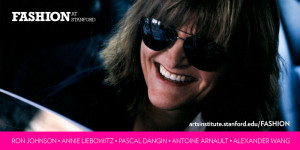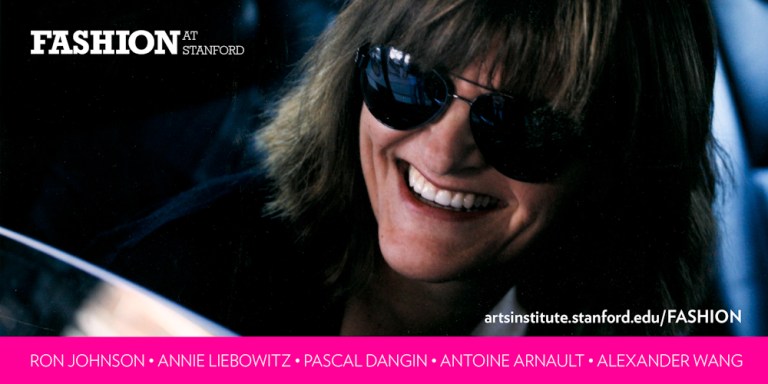
New York Times fashion journalist and critic Cathy Horyn will moderate a series of talks on the fashion industry held by the Stanford Arts Institute, with the first talk to be held on Dec. 2. The series will tap into Stanford students’ growing interest in the fashion industry – seen on campus in the form of new fashion magazine startups and course offerings.
Horyn, with the help of Executive Director of Arts Programs Matthew Tiews ’99 Ph.D. ’04, has organized the speaker series in order to bring in big names from all areas of the fashion industry.
“Fashion presents a lot of ways for people to enter into the conversation,” Horyn said.
From December through April, there will be four talks. The first will be with the former CEO of J.C. Penney, Ron Johnson ’80. The second talk of the series will feature Annie Leibovitz, a portrait and fashion photographer, and Pascal Dangin of Box Studios. The third talk will be with Antoine Arnault, the chief executive officer of Berluti and a member of the Board of Directors at Moët Hennessy Louis Vuitton (LVMH). World-renowned designer Alexander Wang will close the series in April.
Horyn plans to have a general outline for the focus of each talk, noting that each speaker will have a different understanding of the fashion industry.
While Johnson’s talk will focus on the business of fashion, Leibovitz and Pascal’s talk – the only of the four dialogues to feature two speakers at once – will be about image-making and branding. Arnault’s talk will discuss luxury fashion, both as a business and a craft, and the final talk with Alexander Wang will center on design.
This is not the first time the New York-based Horyn has interacted with Stanford. In 2010, she came to campus as a critic-in-residence and she taught workshops on fashion writing.
“There was a great response,” Horyn said. “A lot of students, mostly women, came up to me and they wanted to know a lot about different parts of the fashion industry.”
She said that because of the wide variety of interests and the general entrepreneurial spirit at Stanford, she received interesting questions at the workshops and is expecting the same of this new speaker series.
“They were thinking about jobs, business and the marketing side of fashion – the branding,” Horyn said. “I thought that was kind of interesting. It kind of reflects a shift in fashion right now. Fashion is a lot about marketing and branding.”
Tiews said Horyn helped spark interest in the fashion industry on campus.
“She really inspired a lot of people and also galvanized a certain interest in fashion,” he said.
Because of that program’s success, Tiews knew that he wanted to design another program related to fashion.
“We’d had that in the back of our minds that there was this real kind of interest in fashion and . . . we were trying to think about what we could do to kind of revive that interest for the coming year,” he said.
Because the series attempts to showcase individuals from all sides of the fashion industry – business, marketing, design – Tiews hopes that the series will appeal to many different members of the Stanford community.
“You’ll get a sense of what goes into the fashion world,” he said. “It’s not just someone sitting and designing clothes, but it’s really a very rapidly changing world and all of those pieces have to come together and be understood to really get a handle on what’s happening.”
Tapping into growing interest
Stanford students and faculty are already demonstrating interest in engaging with the fashion industry from various angles.
Two different campus fashion magazine startups have begun just this fall: Mint magazine, which was founded by freshman Ashley Overbeek ’17 and will debut on Dec. 7, and Pulse magazine, which is still waiting for approval as a new student organization from the ASSU before it begins production.
Overbeek, who wrote a fashion column for her high school newspaper, said that she posted a prototype of the magazine on the Class of 2017 Facebook page, hoping to get at least 10 interested students to reply. The post ended up having over 150 responses.
“Brown, U Penn, Columbia, even U Michigan – they all have fashion magazines on campus,” she said. “The fact that Stanford didn’t already have one is a red flag that we’re a little behind.”
Sade Stevens ’17 and Ameeqa Ali ’17, co-founders of Pulse magazine, were surprised when their interest survey received over 70 responses within a week.
“Fashion is not essential to Stanford’s culture, but it still exists,” Ali said.
Elon Cornelius ’15, the campus promoter for the company Rent the Runway – which allows shoppers to rent designer dresses at a low cost for a night – shared similar thoughts.
“When we think about Stanford, we think about this really casual environment where everyone is wearing a sweatshirt, jeans and a startup t-shirt, but there is a strong population of girls who like to dress up, who like to look nice,” he said.
Professors have noted this trend as well.
“[Fashion] is coming into focus at Stanford. That’s a very exciting development,” said Nancy Troy, chair of the Art and Art History Department and author of “Couture Culture: A Study in Modern Art and Fashion.”
Just this year, there are three courses that focus at least part of their attention on fashion: DANCE 67: Being S(c)ene: Dance, Fashion and Art as Exhibition, ARTHIST165A: Fashion Shows: From Lady Godiva to Lady Gaga and TAPS32F: History of Costume and Fashion.
Fashion Shows: From Lady Godiva to Lady Gaga drew over 60 students last year.
“In a period where Stanford, like other schools, is trying to think in interdisciplinary ways and make connections across conventionally separate disciplines or [the] whole school. . . fashion actually can find a legitimate place,” Troy said. “It’s not simply about something superficial. It’s too pervasive.”
Horyn attributes the growing interest in the field to the accessibility of the Internet and also a breaking down of barriers within the industry.
“You don’t have rules that people have to worry about. You don’t have to be in the know to understand anything about fashion,” she said. She explained that the industry is now more welcoming to people outside the realm of fashion expertise, and that this accessibility is appealing to many.
“When people see other people that look like them being involved in fashion rather than stick thin models, I think that that contributes to the way in which fashion is now an industry where everyone can have access and create their own style,” Overbeek said.
If the speaker series is received well, Tiews wants to expand the dialogue about fashion at Stanford.
“I’d love to do more – there are clearly lots of other people in this world who would be interesting to have come to campus,” he said. “I think we’d be interested in hearing from students about people they would particularly like to see.”
Contact Josie Hodson at josie.hodson ‘at’ stanford.edu.
